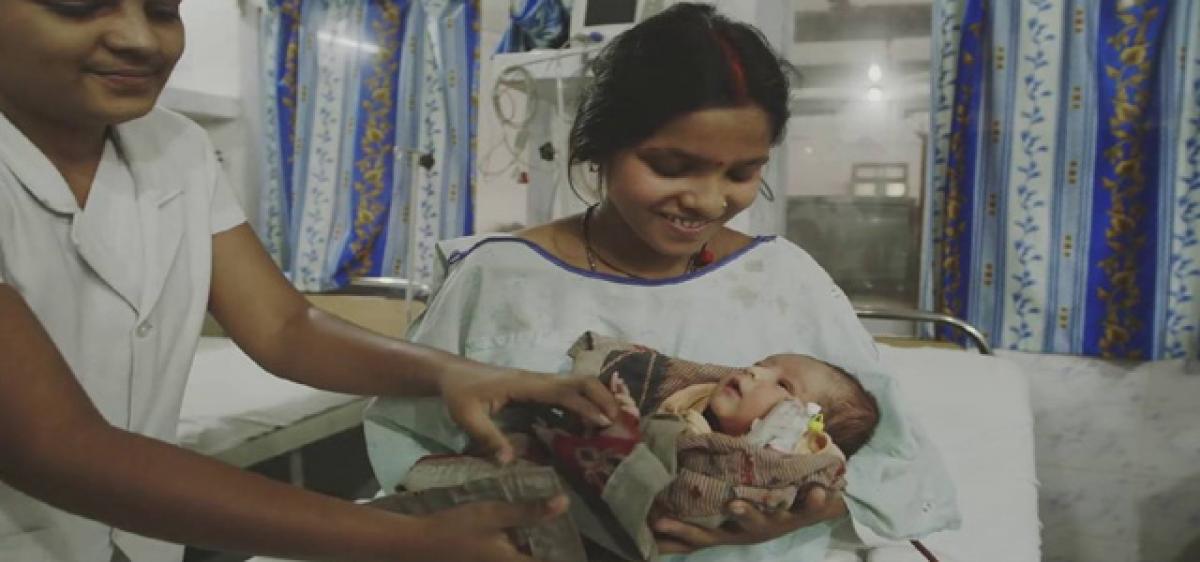Live
- ‘Get Set, Grow Summit 2024’ Focuses on Digital Detox for Families
- Stokes motivates his team to put in extra effort, says England pacer Potts
- From overcoming setbacks to leading India in U19 Women’s Asia Cup, Niki Prasad's amazing journey
- Driving Enterprise Security: Inside Venkata Reddy Thummala’s Leadership Journey
- Constitution debate: PM Modi hails 'Nari Shakti'; makes strong pitch for 'United Bharat’
- Abhijeet Bhardwaj: Revolutionizing Enterprise Analytics with Innovation and Expertise
- Bihar: Inquiry initiated against principal who went to buy veggies during school hours
- Press Sri Lankan Prez for release of Indian fishermen: TN Cong MP to EAM Jaishankar
- TN: DMK postpones executive meet due to heavy rains & Parliament session
- Porous silicon oxide electrodes can fix durability issues in batteries: Researchers
Just In
Childbearing expenses: Telangana State women bear the brunt


Catastrophic maternal healthcare expenses push 46.6 percent mothers in India into poverty-with the illiterate being especially susceptible-according to a December 2016 study by researchers from Jawaharlal Nehru University (JNU) and Indian Institute of Technology, Roorkee (IIT-R). The expenses include childbirth, antenatal care and postnatal care expenses.
Catastrophic maternal healthcare expenses push 46.6 percent mothers in India into poverty-with the illiterate being especially susceptible-according to a December 2016 study by researchers from Jawaharlal Nehru University (JNU) and Indian Institute of Technology, Roorkee (IIT-R). The expenses include childbirth, antenatal care and postnatal care expenses.
The expenditure is greater than or equal to 40 percent of a household's non-subsistence income, like what remains after basic needs have been met, according to the World Health Organisation (WHO). The threshold of 40 percent can differ county-wise, said the WHO; the 2016 study has analysed the data at two thresholds: 10 and 40 percent.As many as 63 percent households nationwide had a catastrophic maternal health expenditure of 40 percent, the study, which analysed data from the National Sample Survey Office, found.
Among States and Union Territories, 65.7 percent households (among those where a woman had delivered) in Telangana were pushed into poverty, followed by Chhattisgarh (53.7 percent) and Puducherry (53.4 percent).In the 10 years to 2014, out-of-pocket (OOP) health spending has pushed 50.6 million people back into poverty.
Households where the mothers were illiterate were the most affected, with 61 percent of them being pushed into poverty-despite having the lowest maternal health OOP expenditure at Rs 3,600-compared to 36.7 percent of households where women were graduates and above, who had an OOP expenditure of Rs 19,250.
More illiterate women prefer public hospitals for delivery in both rural (79.2 percent) and urban areas (67.7 percent), which possibly explains their low OOP.Among women of different social groups, women belonging to Scheduled Tribes had the least maternal OOP expenditure at Rs 2,962, but 71.5 percent of them were pushed into poverty.
As many as 85 percent ST women in rural areas delivered in public hospitals, which is more than any other social group. The study holds relevance in the context of the Centre’s announcement on May 18, 2017, that it is revising the Indira Gandhi Matritva Sahyog Yojana (Maternity Benefit Programme), announced by Prime Minister Narendra Modi on December 31, 2016, by restricting the scheme to firstborns instead of "first two live births" as applicable earlier.The programme aims to give Rs 6,000 to pregnant women for childbearing expenses.
The scheme saw an increase of 226 percent in allocation in the 2017-18 Budget from Rs 634 crore to Rs 2,700 crore. However, the government had reportedly estimated that the annual requirement for the maternity benefit scheme would be Rs 14,512 crore.The 2016 study revealed that, on average, a woman incurred an OOP expenditure of Rs 8,543 on childbearing. There were huge variations among states-from Rs 2,801 in Uttarakhand to Rs 15,433 in Telangana.
"The most vulnerable women who are trying to reach out for the government aid won't be able to get it," Tania Sheshadri, an independent community health researcher who works with rural women in Karnataka, was recently quoted as saying. "In most parts of the country, there is a two-child norm and a scheme like this will not benefit most women. The government should concentrate on quality care for pregnant women and make available the benefits to every woman who reaches a government health care centre."
A limitation of the 2016 study is that it does not consider the benefits of Janani Suraksha Yojana (JSY, motherhood protection scheme), a 12-year-old government programme focused specially on 10 States with low rates of institutional delivery, including Uttar Pradesh, Uttarakhand, Bihar,
Jharkhand, Madhya Pradesh, Chhattisgarh, Assam, Rajasthan, Odisha, and Jammu and Kashmir, termed as low-performing states (LPS).
Under the programme, pregnant women in rural areas who live below the poverty line are to be given cash assistance of Rs 700 in high performing States and Rs 1,400 in LPS, irrespective of the mother's age and number of children so that they opt for birth in a government or accredited private health facility. The scheme has failed to cover the poorest women, according to a 2014 analysis of JSY data by researchers from Georgetown University. (The writer is with Institute of Development Studies, University of Sussex)
By Devanik Saha

© 2024 Hyderabad Media House Limited/The Hans India. All rights reserved. Powered by hocalwire.com






